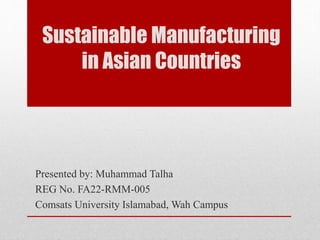
Sustainable Manufacturing in asian countries
- 1. Sustainable Manufacturing in Asian Countries Presented by: Muhammad Talha REG No. FA22-RMM-005 Comsats University Islamabad, Wah Campus
- 2. Concept of Sustainability and Sustainable Manufacturing
- 3. Sustainable Development • The Brundtland commission report, titled Our Common Fire released in 1987 by United Nations World Commission on Environment and Development (WCED) defined sustainability and sustainable development as "Development the meets the needs of the present without compromising the ability of future generations to meet their own needs“ Dr. Gro Harlem Brundtland From Narway is known as Mother of Sustainable Development Philosophy
- 4. Sustainability • According to Dr. Dornfeld, Sustainability means activities whose environmental impact is below the level that thyself recovery capability of the natural environment can deal with. • Prof. Dr. David A. Dornfeld, Laboratory of Manufacturing And Sustainability (LMAS).University of California, Berkely
- 5. Three Pillars of Sustainability Environmental Economic Social Sustainability
- 6. Why Focus on Sustainably • In last 50 years, humans have consumed more resources than in all the previous history. • In total, 60 billions tons of resources are extracted annually, which is 50% more than just 30 years ago. • As much fresh water has been withdrawn in last 30 years, as in last three centuries. • Between 1950 to 2005, worldwide metals production grew by 6 times, oil consumption 8 times and natural gas consumption 14 times against the population grew by 2.25 times (approx. from 3 billions to 7 billions).
- 8. Why Sustainability in Manufacturing • Manufacturing is the most resource intensive processes of all human activities. • In European union, manufacturing accounts for 21% of GDP and involves 20% of all jobs. • Pakistan is expected to increase the share of manufacturing in the overall economy to 18% by 2025 from the current 7%.
- 9. Manufacturing's Share of GDP in Asian Countries
- 10. Why Sustainable Manufacturing • According to research, the manufacturing sector accounts for more than a third of global CO2 emissions. • Rising greenhouse emissions is the third most important global risk. (After chronic fiscal imbalances and water supply crisis) • For sustainable manufacturing, there are a range of issues we need to consider, including product design, innovation, recycling, waste management, infrastructure, financing, green pricing, renewables, life-cycle assessment, governmental support, energy usage, available low-carbon technologies, legislations, market conditions, consumer needs and many more.
- 11. Why Sustainable Manufacturing Manufacturing Mechanical, physical and chemical process to modify the geometry, properties and appearance of a given starting material in the making of new finished part of product. Sustainable Manufacturing The creation of manufactured products that use processes that are non- polluting, conserve energy and natural resources, and are economically sound and safe for employees, communities, and consumers.“
- 12. Sustainable Manufacturing Process • Sustainable manufacturing processes are those which generate minimum quantity of wastes, demonstrating improved environmental performance and energy efficiency while providing operational safety and personal health.
- 13. Some Popular Words • Green Manufacturing • Clean Manufacturing • Environmentally Conscious Manufacturing Environmentally Benign Manufacturing • Environmentally Responsible Manufacturing • Eco-Friendly Manufacturing • Sustainable Manufacturing
- 15. Basic Objective of Sustainability in Manufacturing Activity • Minimize manufacturing cost • Minimize energy consumption • Reduce environmental impact Improve personnel health • Improve operational safety • Improve waste management practices
- 16. Development strategies of Pakistan Strategies to promote growth and development • Trade liberalization. ... • Export promotion. ... • Promotion of FDI. ... • Removal of government subsidies. ... • Floating exchange rate systems. ... • Microfinance schemes. ... • Privatization. ... • Development of human capital.
- 17. Thank You